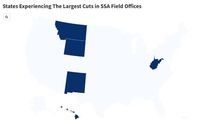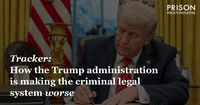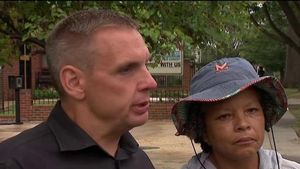Americans seeking help from the Social Security Administration (SSA) or relying on the criminal legal system have faced a year of unprecedented upheaval, as sweeping federal workforce cuts and aggressive policy changes under the Trump administration have left many communities reeling. From rural retirees struggling to access benefits to advocates alarmed by the rollback of legal protections, the landscape for millions has shifted—sometimes overnight.
According to a recent report by the Strategic Organizing Center (SOC), the SSA’s more than 1,200 local field offices—serving over 119,000 visitors daily—have been hit hard by the Department of Government Efficiency’s agency-wide cuts. The numbers are stark: 46 states lost field office staff between March 2024 and March 2025, with more than 30 percent of field offices shedding at least 10 percent of their workers. Wyoming led the list with a 17 percent reduction, followed by Montana (14 percent), West Virginia (11 percent), Hawaii (11 percent), and New Mexico (10 percent).
"What's surprising is the correlation between population density and the states with double-digit declines in SSA field office workers," Kevin Thompson, CEO of 9i Capital Group and host of the 9innings podcast, told Newsweek. "Many of these states have fewer people spread out over larger areas. Add in the SSA's push toward technology and automation, and headcounts in certain offices are going to drop as they modernize. For rural areas, the impact will be immediate. People who once had an office in town might now have to travel to the nearest major city or even the state capital just to get basic answers."
The Trump administration’s February 2025 announcement of a 12 percent workforce cut at the SSA—amounting to roughly 7,000 jobs by the end of the fiscal year—has already resulted in a 5 percent drop in field office staff as of March 2025, from 21,627 to 20,593 employees. The consequences, experts warn, are especially dire in states with aging populations and higher rates of disability. West Virginia, for example, not only saw an 11 percent cut but also has the highest disability rate in the nation. New Mexico and Montana, both in the top 10 for disability rates, also experienced significant reductions.
"It's important to note in some states, the number of employees for the administration in the field are already low, and cutting them further could delay support to some beneficiaries," Alex Beene, a financial literacy instructor at the University of Tennessee at Martin, told Newsweek. "Government efficiency is obviously important, but as a larger size of the population enters retirement and qualifies for benefits, there will be more demand for services Social Security provides."
For rural communities, these changes are more than an inconvenience—they’re a barrier to essential services. Many residents in places like Wyoming and Montana lack reliable internet or computer access, making online alternatives unfeasible. As the SOC report notes, longer drives and fewer in-person options mean that those who need help the most—the elderly and disabled—are left with tough choices. Thompson put it plainly: "For the disabled, that's a huge barrier. These communities already have limited access. This just makes it worse, forcing people to make real-life decisions about whether they can even afford the time, cost, and effort to get the help they need."
But the SSA isn’t the only institution facing seismic change. The Trump administration has simultaneously pursued a series of policy moves that, according to critics, have made the American criminal legal system harsher and less accountable. A detailed tracker compiled by the Prison Policy Initiative outlines a broad campaign: undermining due process, expanding harsh sentencing, shuttering oversight, and slashing funding for programs proven to reduce crime and support vulnerable populations.
Among the most controversial actions: the administration sent hundreds of immigrants to be incarcerated in El Salvador without due process, even defying a unanimous Supreme Court order to return one such individual. Presidential advisor Stephen Miller publicly considered suspending the Writ of Habeas Corpus for undocumented people—a move that would allow imprisonment without judicial review, a power reserved to Congress, not the executive branch.
At the same time, the administration shuttered the Interagency Council on Homelessness, the federal body behind the "Housing First" approach to homelessness, and canceled $11.4 billion in grants aimed at substance use and mental health treatment. The Department of Justice rescinded millions in funding for diversion and violence prevention programs across the country, including $6 million for drug diversion, $2 million for violence prevention in Massachusetts, and millions more targeting youth and gun violence in cities from Oklahoma City to Baltimore. The Office on Violence Against Women froze support for domestic violence victims, while 373 grants to 221 organizations in 37 states were eliminated.
These funding cuts, experts say, will likely drive up incarceration rates and worsen outcomes for those already caught in the system. The administration’s July 2025 mega-bill went further, prohibiting key federal grants from being used for violence-prevention programs, and President Trump signed an executive order pushing states to criminalize homelessness and mental illness—policies critics say will simply swell jail and prison populations.
The approach to law enforcement and sentencing has also shifted. On his first day in office, President Trump ended the federal death penalty moratorium and directed prosecutors to pursue the "most serious, readily provable offenses," a move the Brennan Center warns will "swell the nation's prison population without improving public safety." In April 2025, an executive order expanded policing, threatened state and local officials who don’t cooperate with federal law enforcement, and even called for military involvement in policing.
Perhaps most dramatically, on August 11, 2025, President Trump invoked a never-before-used law to take over Washington, D.C.'s police force and activated the National Guard, despite crime in the city being at a 30-year low. During his remarks, he said police are now “allowed to do whatever the hell they want.”
Conditions inside prisons and jails have also worsened, according to advocates. Executive orders targeted transgender inmates, ending gender-affirming care and mandating that trans women be housed in men’s prisons—though a federal judge temporarily blocked these changes in June 2025. Funding for the Prison Rape Elimination Act Resource Center was eliminated, internet access programs for incarcerated people were cut, and the "Fresh Start" program helping incarcerated students pay for college was ended. Changes to how sentence credits are calculated mean some will serve up to a year longer than expected.
Oversight and transparency have not been spared. The administration has rolled back data collection on gender identity among crime victims, shuttered the National Law Enforcement Accountability Database, and ended or recommended ending consent decrees with police departments accused of constitutional violations. These moves, critics say, make it harder to track abuse and discrimination, and to hold law enforcement accountable.
All told, the combination of federal workforce cuts and aggressive policy shifts has left many Americans—especially the most vulnerable—facing new obstacles at every turn. Whether seeking Social Security assistance or navigating the justice system, the path has grown steeper, the lines longer, and the safety nets thinner. For those on the front lines, the sense is clear: the rules have changed, and not in their favor.





